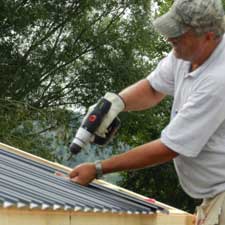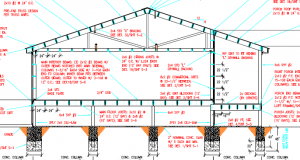Skylights in steel roofs, whether FRP (Fiberglass Reinforced Plastic), Polycarbonate or Lexan pose enough structural problems to warrant not using them. Here is another reason, which I had not considered, but there is a valuable safety reason presented in this article by Gregory Havel appeared January 11, 2016 in Fire Engineering®.
Skylights on the roof of any building are hazardous to firefighters and to anyone else who may have to work on the roof. Firefighters, construction workers, and maintenance personnel have fallen through skylights and skylight openings often enough that the Occupational Safety & Health Administration has included protection of these openings in its regulations, while the National Institute for Occupational Safety and Health (NIOSH) has issued a safety advisory regarding this hazard to firefighters (view this advisory at https://www.cdc.gov/niosh/docs/2016-110/pdfs/2016-110.pdf). NIOSH is presently investigating a July 15, 2015, firefighter fatality of an injury sustained after a firefighter fell through one of these skylight panels on June 28, 2015. Injuries and fatalities from falls through these skylight panels are too frequent, and they are well-documented by OSHA and by NIOSH.
Unfortunately, the OSHA requirements have not been added to building codes, and architects and engineers may not be aware of them. As a result, many buildings are constructed with no fall protection at skylight openings.
OSHA’s 29 CFR 1910.23 (a)(4) states “Every skylight floor opening and hole shall be guarded by a standard skylight screen or a fixed standard railing on all exposed sides.” 29 CFR 1910.23 (e)(8) describes the construction and strength requirements for skylight screens: “Skylight screens shall be of such construction and mounting that they are capable of withstanding a load of at least 200 pounds applied perpendicularly at any one area on the screen. They shall also be of such construction and mounting that under ordinary loads or impacts, they will not deflect downward sufficiently to break the glass below them. The construction shall be of grillwork with openings not more than 4 inches long or of slatwork with openings not more than 2 inches wide with length unrestricted.” 29 CFR 1910.501 (a) and (b) further address skylight openings from the standpoint of fall protection. (These regulations are available in print from your local OSHA office, and at www.osha.gov at no cost. Click on “Standards” in the right column of the OSHA homepage, on “General Industry” on the next page, and scroll down to 1910.23 and 1910.501 in the index page.)
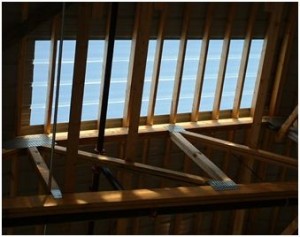 Photo 1 shows a skylight from inside a “pole building” constructed to store lumber at a homeowners’ supply store. The plastic skylight panel is corrugated to match the painted steel roof panels; it is attached by screws to the wood framing, as are the adjoining metal panels. The skylight and metal roof panels are supported by 2 x 6 joists on 24-inch centers, which are supported by wood trusses on eight-foot centers. Although the 2 x 6 joists span the skylight opening, they don’t qualify as skylight fall protection according to OSHA’s standards. There is enough space between them for a firefighter to fall through to the concrete floor more than 20 feet below.
Photo 1 shows a skylight from inside a “pole building” constructed to store lumber at a homeowners’ supply store. The plastic skylight panel is corrugated to match the painted steel roof panels; it is attached by screws to the wood framing, as are the adjoining metal panels. The skylight and metal roof panels are supported by 2 x 6 joists on 24-inch centers, which are supported by wood trusses on eight-foot centers. Although the 2 x 6 joists span the skylight opening, they don’t qualify as skylight fall protection according to OSHA’s standards. There is enough space between them for a firefighter to fall through to the concrete floor more than 20 feet below.
During daylight hours, these panels will be conspicuous when viewed from the interior of the building and will appear a different color than the rest of the roof when viewed from the exterior. At night, when snow-covered, or when obscured by smoke, the difference between the metal and plastic panels may not be visible.
If the skylight panels are of a thermoplastic material, a fire inside the building will soften or melt them. If the panels are of a thermoset material, they may crack from the heat of a fire inside the building; or they may burn through. In either case, they may self-vent and eliminate the need for firefighters on the roof.
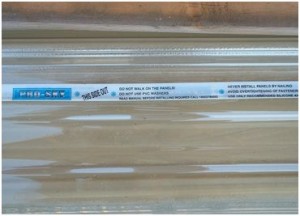 Photo 2 shows the label that is placed continuously from end to end by many skylight manufacturers on two ribs of each sheet of skylight material. This label will be visible only from the top side of the panel and only if we are looking for it. The first line, next to “This Side Out” is very specific:
Photo 2 shows the label that is placed continuously from end to end by many skylight manufacturers on two ribs of each sheet of skylight material. This label will be visible only from the top side of the panel and only if we are looking for it. The first line, next to “This Side Out” is very specific:
“DO NOT WALK ON THE PANELS!”
Let’s take that advice a step farther: Let’s not walk on this roof at all! This is a lightweight roof designed to keep out the weather and to support workers during installation, with plastic skylight panels that are not designed to support anyone at any time. It is supported on lightweight wood trusses. The manufacturers know this and believe that they have done their part in providing the warning label. If there is a fire below that needs to be ventilated, it will ventilate itself through the skylight panels (if the roof trusses do not collapse first).
The skylights used on roofs of “engineered steel buildings” (similar to pole buildings, but with steel framing; do an Internet search for this term for manufacturer and trade association literatures) are made of similar plastic material installed in a similar fashion.
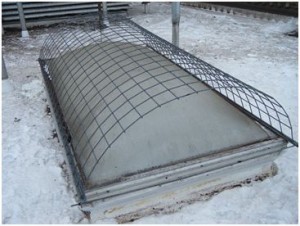 Photo 3 shows a plastic dome skylight with OSHA-compliant fall protection on the outside of the skylight. Although this fall protection screen is designed to support a load of 200 pounds applied vertically onto the screen, we must keep in mind that a mature firefighter in full personal protective equipment will weigh more than the 200-pound design load and that a falling firefighter is a dynamic load rather than a static load. (Do an Internet search for “skylight fall protection” and “skylight fall protection systems” for commercially-available products—including guardrails—for fall protection at skylights.)
Photo 3 shows a plastic dome skylight with OSHA-compliant fall protection on the outside of the skylight. Although this fall protection screen is designed to support a load of 200 pounds applied vertically onto the screen, we must keep in mind that a mature firefighter in full personal protective equipment will weigh more than the 200-pound design load and that a falling firefighter is a dynamic load rather than a static load. (Do an Internet search for “skylight fall protection” and “skylight fall protection systems” for commercially-available products—including guardrails—for fall protection at skylights.)
Let’s stay off these roofs, unless we are supported by an aerial apparatus rather than by the roof itself. If we need to ventilate the roof, gable ventilation may be a better choice since it is nearly as effective and will keep us off the roof.
Engineered steel and pole buildings are common throughout North America and other parts of the world in commercial, industrial, and agricultural use. If we note these styles of construction on our prefire plans and operational procedures and the presence of skylight panels that will not support firefighters and that may self-vent, our incident commanders will be more likely to choose tactics that will keep us off these roofs. This information must be included in periodic review of prefire plans and operational procedures with firefighters and officers at all levels and must be included in briefings for automatic-aid and mutual-aid agencies at incidents involving these structures.
See https://www.cdc.gov/niosh/docs/2004-156 and https://www.cdc.gov/niosh/docs/2004-156/pdfs/2004-156.pdf for additional information.
Also, please avail yourself to read my earlier dissertation on skylights: https://www.hansenpolebuildings.com/2012/01/skylights/
